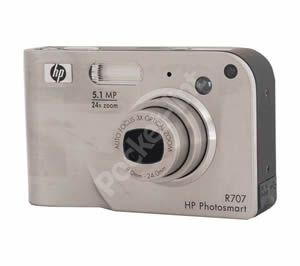HP isn't a name you normally associate with digital photography. So what makes the printer and scanner company think it's got what it takes to go up against the big traditional brands such as Olympus, Canon or Nikon?
Our quick take
The camera offered fast start up, fast zoom and fast save times to the internal memory. The two complaints we have are firstly the save time to the SD card as it wasn't very fast. Take three or four shots in succession and you'll have a camera that is out of action for some time as the buffer works away to clear itself. Secondly, the flash can occasionally overcompensate.
However, if you aren't planning lots of action shots or those featuring you and your friends in dimly lit environments (like a nightclub and so on) then this offers plenty to the novice digital photographer looking to learn their first digital camera rather than just being confused all the time.
As a compact point and shoot the R707 has three good elements. 1. Good looks, 2. Incredibly easy to use and, 3. A picture quality to match the first two.

HP R707 digital camera - 4.0 / 5
| FOR | AGAINST |
|---|---|
|
|
Just as history students sometimes make great accountants, Hewlett Packard's strength here is thinking outside the box. Because of this there's a number of features on the R707 that we haven't seen before in a digital camera. The first is the built-in red eye reduction. Now instead of connecting it to a computer then starting up your photo editing suite and then fixing the red eye, you can do the whole lot in the camera on the fly. This of course has a number of advantages mainly that you can fix the red-eye and then print straight from the camera without the need of a PC or Mac.
The second thing that we've never seen in a digital camera before is an image advisor. Rather than just giving you a histogram, which for the most part nobody understands, the camera analyses your images, and in words, explains how you might go about improving the shot for next time. We tested this in macro mode without a tripod. Sure enough the suggestion was that our images were slightly blurry. The advice was that our picture could be improved by steadying the camera as well as making sure there was a better light source. Beyond this, the camera also contains a built-in manual in case you get stuck or need help when you're out in the field.
Novelty features aside the camera has been revamped in both style and usability since any previous outings. The menu system is a breeze to use and the buttons on the rear of the camera surrounding the 1.5in colour LCD all spell out what they do without any real thought. The LCD was clear to see in most conditions, including one of the bright sunny winter days that we tested the camera on. In fact the only problem we can see (although didn't suffer from) is the location of the two shutter buttons on the top of the camera. The larger of the two (see images) is the still capture, while the smaller one is for movie mode. A quick press of the wrong one and you've missed your shot.
The camera has also had a styling overhaul as well and the camera is half brushed stainless-steel and half high impact rubber giving the camera a durable feel to it. The result is a compact that is not only comfortable to use, but also one that feels sturdy enough to be carried about on holiday or down the pub. Connecting to the PC is either via USB2.0 or with an optional camera dock (reviewed here).
As this camera is geared towards the novice user, the R707 sports 10 shooting modes. While not the plethora that normally accompany a Canon or Pentax model (12-14) the 10 should still be enough, if you remember them to suit a picture you are taking: Auto, Aperture priority AE, Portrait, Action, Landscape, Beach and Snow, Sunset, Panorama, Document, Custom ('My Mode'), and Movie (with sound).
To save all your images on the camera comes with 32Mb of memory built-in with the option of expanding this with an additional SD card. The only annoying feature we found was that with a SD card in the camera, you weren't able to access the internal memory without taking the card out. It's really the only blot we could find on the model.
All these features are great, but if the camera's image quality is poor then what's the point. Luckily for HP it has concentrated as much on the stylish and feature of the model as it has on the image quality.
With 5 megapixels at its disposal, the images were detailed. Hewlett Packard also boasts that the R707 features Adaptive Lighting Technology (ALT), which automatically adjusts high-contrast photos to bring faces out of shadows and details out of backgrounds. The photos we took in our tests were well balanced with vivid yet natural colours, proving that this marketing speak actually does make a difference. However in our test shots we did find that large blocks of colour lost some detail (see inside of blue jacket in sample shots) but nothing that would be too concerning at standard print sizes.
The focus managed to capture the detail we wanted rather than picking up stray elements in the picture. The flash did have a tendency to overwork when subjects were close by, and it's a shame you can't decrease the setting manually. The 3x zoom (35-117 equivalent to 35mm) is standard in a camera of this styling and means that it would be ideal for parties and general pictures rather than capturing images from afar.
To recap
This is a great point and shoot from HP for the novice digital photographer
